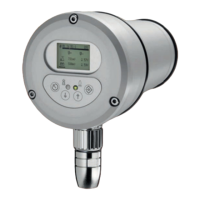104
14 Appendix
1
The product must not be operated outside the specified range. If it is, any guarantees with regard to safety-related functions lose
their validity.
2
If the critical load is exceeded (e.g. as a result of a contactor load), the specified minimum value is no longer guaranteed. The min-
imum value is important for PLC-type applications.
Input parameters
Supply voltage: 230 VAC +10 %, -15 %
115 VAC +15 %, -15 % (optional)
Can only be done at the factory.
Power consumption: ≤ 6 VA
Mains frequency: 45 ... 65 Hz
Allocated fuse in the device, secondary:
315 mA slow-blow
Output parameters
Output no-load voltage < 33 V
Maximum current drain: 0.25 A
Output contact, safe Changeover switch (potential-free)
Permissible switching voltage:
1
Max. 250 VAC, 48 VDC
Min. 6 VAC/DC
Permissible switching current:
1
Max. 0.5 A cosφ 0.4
Min. 10 mA (for a critical load of 50 mA)
2
Allocated fuse in the device:
1
500 mA slow-blow IEC
Output contact, signal contact Normally open contact (potential-free)
Permissible switching voltage:
1
Max. 250 VAC, 30 VDC, min. 6 VAC/DC
Permissible switching current: Max. 0.5 A, min. 10 mA (for a critical load of 50 mA)
External fuse protection: ≤ 500 mA slow-blow
Connection cross-section
Flexible:
Rapid:
0.5 … 2.5 mm
2
/ 20 AWG ... 13 AWG
0.5 … 4.0 mm
2
/ 20 AWG ... 11 AWG
Extension cable with F300K
Cable length Maximum extension after 3 m connecting cable:
0.5 mm
2
50 m/ 20 AWG 164,04 ft
1.0 mm
2
100 m/ 17 AWG 328,08 ft
Technical capacity
Mode: Continuous operation
Safety integrity level: DIN EN 61508:2011 (SIL 2)
Overvoltage category: DIN EN 60730-1, ÜKIII
Climatic range
Protection class:
1
FN20: IP20 - following installation, IP40 must be achieved as
a minimum.
FN20-10: IP66
Protection class: Isolation class II

